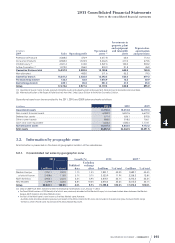Loreal 2011 Annual Report Download - page 99
Download and view the complete annual report
Please find page 99 of the 2011 Loreal annual report below. You can navigate through the pages in the report by either clicking on the pages listed below, or by using the keyword search tool below to find specific information within the annual report.
97REGISTRATION DOCUMENT − L’ORÉAL 2011
2011 Consolidated Financial Statements
4
Notes to the consolidated nancial statements
For business combinations carried out after January1st, 2010, the
main changes with regard to previously applicable accounting
principles are set out below:
♦for each acquisition, the Group chooses whether to
recognise the full amount of goodwill regardless of the
ownership interest acquired, or an amount of goodwill
corresponding to its interest in the acquired company
(previously the only method allowed);
♦deferred tax assets recognised after the initial accounting
is complete are included in profit or loss, and in contrast
to previous practices, the amount of goodwill that would
have been recorded had the deferred tax asset been
recognised as an identifiable asset at the acquisition date
is not deducted;
♦costs incurred in respect of a business combination are
now expensed and no longer included in the cost of the
acquisition;
♦the cost of the acquisition, which includes contingent
consideration, is recognised and measured at its acquisition-
date fair value. Subsequent changes in fair value, affecting
in particular the contingent consideration recorded in
liabilities, are taken to
Other income and expenses
in the
income statement
and no longer treated as an adjustment
to goodwill;
♦any previous interest held in the acquiree prior to the date
control was obtained is now remeasured at its acquisition-
date fair value, with the corresponding gain or loss on
remeasurement taken to the income.
1.15.2. Other intangible assets
Intangible assets are recorded on the balance sheet at cost.
Intangible assets identified following an acquisition are also
included in this item. They mainly consist of trademarks, product
ranges, formulas and patents.
With regard to trademarks, the use of the discounted cash flow
method is preferred to enable the value in use to be monitored
more easily following the acquisition.
Two approaches have been adopted to date:
♦premium-based approach: this method involves estimating
the portion of future cash flows that could be generated by
the trademark, compared with the future cash flows that the
activity could generate without the trademark;
♦royalty-based approach: this involves estimating the value
of the trademark by reference to the levels of royalties
demanded for the use of similar trademarks, based on sales
forecasts drawn up by the Group.
These approaches are based on a qualitative analysis of the
trademark in order to ensure that the assumptions selected
are relevant. The discount rate used is based on the weighted
average cost of capital (WACC) for the target acquired.
Terminal growth rates are consistent with available market data
(generally around 3%, except in specific cases).
A trademark may have a finite or an indefinite life span.
Local trademarks which are to be gradually replaced by an
international trademark already existing within the Group have
a finite life span.
They are amortised over their useful lives as estimated at the
date of acquisition.
International trademarks are trademarks which have an
indefinite life span. They are tested for impairment at least once a
year during the fourth quarter, and whenever an adverse event
occurs. Adverse events may result among other things from an
increase in market interest rates or from a decrease in actual
sales or operational profit compared to forecasts.
The impairment test consists of calculating the recoverable
amount of the trademark based on the model adopted when
the acquisition took place.
Product ranges include all items comprising a franchise: product
concept, complementary name in addition to the trademark,
formulas and patents used, packaging, logos, advertising
trademarks, etc.
The life span of a product range is limited: a range reaches the
end of its life span when its main underlying elements such as
packaging, name, formulas and patents, are no longer used.
Product ranges are therefore amortis ed over their remaining life
span, estimated at the date of acquisition.
The Group may decide to identify and value patents and
formulas that it intends to develop.
The value of a patent or a formula is assessed on the basis of
the future profits expected from its ownership in the future, in
accordance with the royalty-based approach.
The amortis ation period applicable to patents corresponds to
the period during which they enjoy legal protection. Formulas,
which are not protected by legal means, are amortis ed over a
maximum period of 5years.
Market shares and business concern accounted for in the
consolidated financial statements prepared in accordance
with French accounting standards do not meet the definition
of a separable intangible asset and were reclassified under
Goodwill
on the transition to IFRS on January1st, 2004.
1.16. Property, plant and equipment
Property, plant and equipment are recorded on the balance
sheet at cost and are not revalued.
Significant capital assets financed through capital leases,
which transfer to the Group substantially all of the risks and
rewards inherent to their ownership, are recorded as assets on
the balance sheet. The corresponding debt is recorded within
borrowings and debt on the balance sheet.
Investment subsidies are recorded as liabilities under
Other
current liabilities.
























